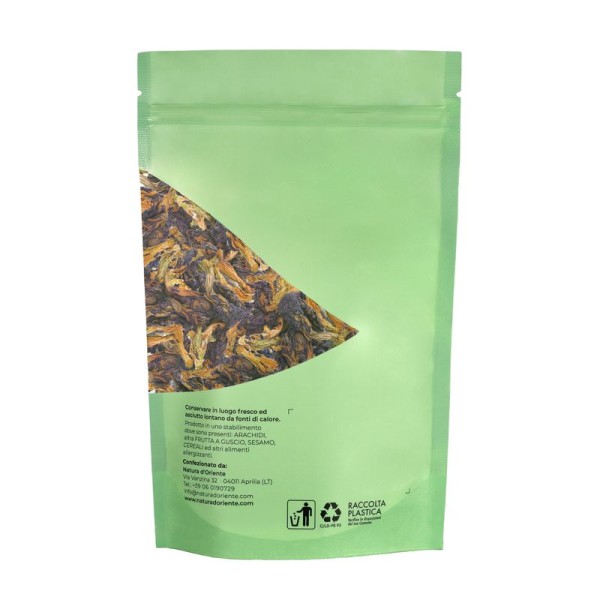The flowers of the Clitoria Ternatea L. plant known as Butterfly Pea or blue pea, are ready for the so-called blue tea, which comes from the infusion of the flowers to which it gives an intense shade of this color. The infusion represents a source of well-being and beauty thanks to the content of antioxidants, free of artificial flavors and colorings. The flowers are also considered a scenographic element to create a colorful drink, with a sweet and delicate, slightly earthy flavor (the hint of peas).
Blue pea flowers: properties and benefits
Butterfly pea infusion is also called blue tea, and is considered a natural source of anthocyanins and flavonoids – antioxidants beneficial to our body. The flower donates these organic compounds, which help our body fight free radicals. In particular, the flowers take their color from anthocyanins - antioxidants that promote correct blood circulation by stimulating certain vasodilator agents.
Pea flowers give a bright blue shade to the drink, but are also used to color cocktails, smoothies and dishes. The color is reminiscent of the famous Prussian blue, but changes with the acidity of the infusion (based on the pH): it turns towards purple if you insert an element such as lemon or lime. For this reason, flowers represent a well-known element for creating cocktails with an intense blue or purple color.
Other elements contained in the Butterfly Pea flower are considered useful for the skin and hair, increasing hydration. The content of vitamins A and C, which contributes to skin beauty, is strengthened by other minerals such as potassium, zinc and iron.
Pea flowers have a beneficial soothing and hydrating impact on the skin, and with their richness in anthocyanins they also help blood microcirculation, useful for the beauty and tone of the epidermis. For this reason, some cosmetics incorporate blue pea flowers into shampoos, facial tonics or creams.
Origins and history of cultivation
The blue pea, also called butterfly pea or bula telang, is a plant native to Asia, historically cultivated in south-east Asia and Thailand. The origin can be traced back to the island of Ternate, in eastern Indonesia (Molucca Sea) – in fact, botanically it is the Clitoria ternatea. The plant gets its English name from the butterfly shape of the large blue flowers. In the classic version, the name Clitoria derives from the shape associated with the female genital organ. In traditional Chinese medicine (TCM) they have been considered for centuries as phytotherapy remedies. They were flowers suitable for the cold nature, with a bitter taste that gives an affinity with the meridians of the large intestine and liver. Among some populations, the flowers of the butterfly pea were believed to have an aphrodisiac effect. In Ayurveda, a system of holistic medicine practiced in India for thousands of years, Butterfly Pea herbal tea was used to relax and treat agitation. In Indian territory, blue pea flower infusion is called Anchan tea, and is used in devotional ceremonies to represent love, serenity and protection.
Today the flowers are used for the preparation of sweets, desserts, colored drinks or cocktails. They are very popular for infusion, often together with other ingredients such as honey and lemon.
Plant and flowers
The Clitoria ternatea, blue pea or cordofan pea is a species that belongs to the Fabaceae (legume) family.
It grows spontaneously at the edges of forests or near river banks, while it is cultivated as an ornamental plant or to fix nitrogen to the soil - as the pea is a legume. The intense blue flowers, with white shades, precede the fruits: flattened pods containing 6 to 10 seeds per pod. The seeds or peas can be eaten fresh when they are tender, and the flowers are also edible.
Nutritional values of Butterfly Pea flowers
They are rich in anthocyanin compounds called ternatines, and antioxidants including the flavonoid kaempferol. Other elements considered useful in blue pea flowers are p-coumaric acid, and delphinidin-3,5-glucoside. Butterfly Pea flowers also contain vitamins A and C, which contribute to healthy vision and skin. They make potassium, zinc and iron available. How to use Butterfly Pea flowers
The infusion, also known as blue tea, is obtained by placing approximately 3-5 grams of dehydrated flowers with 100° water in a cup (250 ml). C. Leave to infuseand the time indicated on the package, before drinking.
Add honey, a little lemon or lime juice if desired. The acidity of citrus fruits (if you add lemon) can make the herbal tea take on a shade closer to deep purple.
At a food level, Butterfly Pea flowers can be included as coloring ingredients for various recipes. The flavor is delicate with some sweet and floral notes, ideal for creating alcoholic or non-alcoholic cocktails, shakes, smoothies.
They can be broken up and inserted into a solution of water or vegetable milk, to color creams, ice creams, yogurt, cheesecakes or puddings.
The flowers of the blue pea are also used in cooking to color sauces, desserts, rice, sweets and cakes, etc. When preparing white rice, the flowers must be added to the cooking water, for risotto the final creaming must be done with the flowers in the form of powder.
They can pigment baked products such as bread, donuts, brioches and muffins . The dehydrated flowers are added to the mixture to obtain the blue naturally, after having dissolved them in water or milk.
Butterfly Pea flowers: side effects and contraindications
The pea flower is generally considered safe, if the recommended doses are respected. In case of excessive intake, side effects such as nausea, stomach pain and diarrhea are possible. They are not recommended for pregnant and breastfeeding women.











 No reward points for this product.
No reward points for this product.
